Evaluation of the Temporal and Spatial Changes of Ecological Quality in the Hami Oasis Based on RSEI
Abstract
1. Introduction
2. Materials and Methods
2.1. Study Area
2.2. Data Sources and Preprocessing
2.3. Research Methods
2.3.1. Remote Sensing Ecological Index
2.3.2. Standard Deviation Ellipse Analysis
2.3.3. Moving Window Method
2.3.4. Geo-Detector Model
2.3.5. Spatial Autocorrelation Analysis
3. Results
3.1. Principal Component Analysis of the Ecological Environment Index
3.2. Oasis Ecological Environment Quality Classification
3.3. Dynamic Monitoring of the Ecological Environment Quality in the Hami Oasis
3.4. External Overall Analysis of the Ecological Quality of the Hami Oasis Based on the Standard Deviation Ellipse Method
3.5. Internal Detailed Analysis of Ecological Quality in the Hami Oasis Based on the Moving Window Method
4. Discussions
4.1. Analysis of Driving Factors of the Hami Oasis Based on Geographic Detector
4.2. Spatial Clustering of the Ecological Environment of Hami Oasis
5. Conclusions
Author Contributions
Funding
Acknowledgments
Conflicts of Interest
References
- Ingram, H.A.P. Ecohydrology of Scottish peat lands. Trans. R. Soc. Edinb. Earth Sci. 1987, 78, 287–296. [Google Scholar] [CrossRef]
- Ling, H.; Xu, H.; Fu, J.; Fan, Z.; Xu, X. Suitable oasis scale in a typical continental river basin in an arid region of China: A case study of the Manas River Basin. Quat. Int. 2013, 286, 116–125. [Google Scholar] [CrossRef]
- Qi, S.; Li, X.; Duan, H. Oasis land-use change and its environmental impact in Jinta Oasis, arid northwestern China. Environ. Monit. Assess. 2007, 134, 313–320. [Google Scholar] [CrossRef]
- Luo, G.-Q.; Zhou, C.-H.; Chen, X.; Li, Y. A methodology of characterizing status and trend of land changes in oases: A case study of Sangong River watershed, Xinjiang, China. J. Environ. Manag. 2008, 88, 775–783. [Google Scholar] [CrossRef] [PubMed]
- Zhou, D.; Wang, X.; Shi, M. Human driving forces of oasis expansion in north-western China during the last decade-a case study of the Heihe River Basin. Land Degrad. Dev. 2017, 28, 412–420. [Google Scholar] [CrossRef]
- Zuo, L.-J.; Zhang, Z.-X.; Zhao, X.-L.; Wang, X.; Wu, W.-B.; Yi, L.; Liu, F. Multitemporal analysis of cropland transition in a climate-sensitive area: A case study of the arid and semiarid region of northwest China. Reg. Environ. Chang. 2014, 14, 75–89. [Google Scholar] [CrossRef]
- Fan, Q.; Ding, S. Landscape pattern changes at a county scale: A case study in Fengqiu, Henan Province, China from 1990 to 2013. Catena 2016, 137, 152–160. [Google Scholar] [CrossRef]
- Zhu, Z.; Liu, S.; Di, X. Desertification and Rehabilitation in China; Academic Press: Beijing, China, 1988; pp. 205–218. [Google Scholar]
- Duan, H.-C.; Wang, T.; Xue, X. Dynamic monitoring of aeolian desertification based on multiple indicators in Horqin Sandy Land. China. Sci. Total Environ. 2019, 650, 2374–2388. [Google Scholar] [CrossRef]
- WHO. Millennium Ecosystem Assessment. In Ecosystems and Human Wellbeing: Synthesis; Island Press: Washington, DC, USA, 2005; p. 137. Available online: http://refhub.elsevier.com/S0341-8162(19)30516-8/h0140 (accessed on 5 September 2020).
- Feng, S.; Fu, Q. Expansion of global drylands under a warming climate. Atmos. Chem. Phys. 2013, 13, 81–100. [Google Scholar] [CrossRef]
- Feng, Q.; Ma, H.; Jiang, X.-M. What has caused desertification in China. Sci. Rep. 2015, 5, 15998. [Google Scholar] [CrossRef] [PubMed]
- Xue, Y. Interactions and feedbacks between climate and dryland vegetation. In Dryland Ecohydrology; D’Odorico, P., Porporato, A., Eds.; Springer: New York, NY, USA, 2006; pp. 85–105. [Google Scholar] [CrossRef]
- Aspinall, R. Modelling land use change with generalized linear models—A multi-model analysis of change between 1860 and 2000 in Gallatin Valley, Montana. J. Environ. Manag. 2004, 72, 91–103. [Google Scholar] [CrossRef] [PubMed]
- Bakker, M.-M.; Govers, G.; Kosmas, C. Soil erosion as a driver of land-use change. Agric. Ecosys. Environ. 2005, 105, 467–481. [Google Scholar] [CrossRef]
- Feng, Y.-X.; Luo, G.-P.; Zhou, D.-C. Effects of land use change on landscape pat-tern of a typical arid watershed in the recent 50 years: A case study on Manas River watershed in Xinjiang. Acta Ecol. Sin. 2010, 30, 4295–4305. [Google Scholar] [CrossRef]
- Bai, J.; Chen, X.; Li, L.; Luo, G.; Yu, Q. Quantifying the contributions of agricultural oasis expansion, management practices and climate change to net primary production and evapotranspiration in croplands in arid northwest China. J. Arid Environ. 2014, 100, 31–41. [Google Scholar] [CrossRef]
- Guo, M.; Yu, W.-B.; Ma, M.-G.; Li, X. Study on the oasis landscape fragmentation in northwestern China by using remote sensing data and GIS: A case study of Jinta oasis. Environ. Geol. 2008, 54, 629–636. [Google Scholar] [CrossRef]
- Hu, N.-K.; Li, X. Spatial distribution of an ancient agricultural oasis in Juyan, northwestern China. Front. Earth Sci. Prc. 2014, 338–350. [Google Scholar] [CrossRef]
- Wang, Y.; Gao, J.-X.; Wang, J.-S.; Qiu, J. Value assessment of ecosystem services in nature reserves in Ningxia, China: A response to ecological restoration. PLoS ONE 2014, 9. [Google Scholar] [CrossRef]
- Lamqadem, A.A.; Saber, H.; Pradhan, B. Quantitative assessment of desertification in an arid oasis using remote sensing data and spectral index techniques. Remote Sens. 2018, 10, 1862. [Google Scholar] [CrossRef]
- Boali, A.; Bashari, H.; Jafari, R. Evaluating the potential of Bayesian networks for de-sertification assessment in arid areas of Iran. Land Degrad. Dev. 2019, 30, 371–390. [Google Scholar] [CrossRef]
- Wang, T.; Sun, J.G.; Han, H. The relative role of climate change and human ac-tivities in the desertification process in Yulin region of northwest China. Environ. Monit. Assess. 2012, 184, 7165–7173. [Google Scholar] [CrossRef]
- Wang, R.-H.; Zhang, H.-Z.; Huang, Q. Characteristics and laws of MODS coupling rela-tion in and zone under global change. Chin. Sci. Bull. 2006, 51, 75–81. [Google Scholar] [CrossRef]
- Falcucci, A.; Maiorano, L.; Boitani, L. Changes in land-use/land-cover patterns in Italy and their implications for biodiversity conservation. Landsc. Ecol. 2007, 22, 617–631. [Google Scholar] [CrossRef]
- Yang, G.; Chen, D.; He, X.-L. Land use change characteristics affected by water saving practices in Manas River Basin, China using Landsat satellite images. Int. J. Agric. Biol. Eng. 2017, 10, 123–133. [Google Scholar]
- Misak, R.F.; Baki, A.A.A.; ElHakim, M.S. On the causes and control of the waterlogging phenomenon, Siwa Oasis, northern Western Desert, Egypt. J. Arid Environ. 1997, 37, 23–32. [Google Scholar] [CrossRef]
- Siebert, S.; Nagieb, M.; Buerkert, A. Climate and irrigation water use of a mountain oasis in northern Oman. Agric. Water Manag. 2007, 89, 1–14. [Google Scholar] [CrossRef]
- Su, Y.-Z.; Zhao, W.-Z.; Su, P.-X.; Zhang, Z.-H.; Wang, T.; Ram, R. Ecological effects of desertification control and desertified land reclamation in an oasis–desert ecotone in an and region: A case study in Hexi Corridor, northwest China. Ecol. Eng. 2007, 29, 117–124. [Google Scholar] [CrossRef]
- Ochoagaona, S.; Kampichler, C.; Bhj, D.J. A multi-criterion index for the evalua-tion of local tropical forest conditions in Mexico. For. Ecol. Manag. 2010, 260, 618–627. [Google Scholar] [CrossRef]
- Sullivan, C.A.; Skeffington, M.S.; Gormally, M.J. The ecological status of grasslands on lowland farmlands in western Ireland and implications for grassland classification and nature value assessment. Biol. Conserv. 2010, 143, 1529–1539. [Google Scholar] [CrossRef]
- Gupta, K.; Kumar, P.; Pathan, S.K. Urban Neighborhood Green Index—A measure of green spaces in urban areas. Landsc. Urban Plan. 2012, 105, 325–335. [Google Scholar] [CrossRef]
- Chen, X.-Y.; Chau, K.-W. A hybrid double feedforward neural network for suspended sediment load estimation. Water Resour. Manag. 2016, 30, 2179–2194. [Google Scholar] [CrossRef]
- Shamshirband, S.; Nodoushan, E.-J.; Adolf, J.-E.; Manaf, A.-A.; Mosavi, A.; Chau, K. Ensemble models with uncertainty analysis for multi-day ahead forecasting of chlorophyll a concentration in coastal waters. Eng. Appl. Comput. Fluid Mech. 2019, 13, 91–101. [Google Scholar] [CrossRef]
- Chau, K.-W.; Jiang, Y.-W. Three-Dimensional pollutant transport model for the Pearl River Estuary. Water Res. 2002, 36, 2029–2039. [Google Scholar] [CrossRef]
- Moran, M.-S.; Peterslidard, C.-D.; Watts, J.M.; Mcelroy, S. Estimating soil moisture at the watershed scale with satellite-based radar and land surface models. Can. J. Remote Sens. 2004, 30, 805–826. [Google Scholar] [CrossRef]
- Foody, G.-M. Editorial: Ecological applications of remote sensing and GIS. Ecol. Inform. 2007, 2, 71–72. [Google Scholar] [CrossRef]
- Ju, W.-M.; Ping, G.; Wang, J. Combining an ecological model with remote sensing and GIS techniques to monitor soil water content of croplands with a monsoon climate. Agric. Water Manag. 2010, 97, 1221–1231. [Google Scholar] [CrossRef]
- Malekmohammadi, B.; Blouchi, L.-R. Ecological risk assessment of wetland ecosystems using Multi Criteria Decision Making and Geographic Information System. Ecol. Ind. 2014, 41, 133–144. [Google Scholar] [CrossRef]
- Ye, Y.-H.; Liang, Y.-X.; Sheng, Y.-Q.; Xie, L.-S. Several issues worthy of discussion in the Technical Specifications for Assessment of Ecological Environment. Trop. Geogr. 2009, 29, 404–406. [Google Scholar]
- Xu, H.-Q.; Tang, F. A new generation of Landsat series satellites: New features of Landsat8 remote sensing imagery and its ecological and environmental significance. Acta Ecol. Sin. 2013, 33, 3249–3257. [Google Scholar]
- Hu, X.-S.; Xu, H.-Q. A new remote sensing index for assessing the spatial heterogeneity in urban ecological quality: A case from Fuzhou City, China. Ecol. Indic. 2018, 89, 11–21. [Google Scholar] [CrossRef]
- Xu, H.-Q.; Wang, M.-Y.; Shi, T.-T.; Guan, H.-D.; Fang, G.-Y.; Lin, Z.-L. Prediction of ecological effects of potential population and impervious surface increases using a remote sensing based ecological index (RSEI). Ecol. Indic. 2018, 93, 730–740. [Google Scholar] [CrossRef]
- Bai, X.-Y.; Du, P.-J.; Guo, S.-C.; Zhang, P.; Lin, C.; Tang, P.-F.; Zhang, C. Monitoring Land Cover Change and Disturbance of the Mount Wutai World Cultural Landscape Heritage Protected Area, Based on Remote Sensing Time-Series Images from 1987 to 2018. Remote Sens. 2019, 11, 1332. [Google Scholar] [CrossRef]
- Yue, H.; Liu, Y.; Li, Y.; Lu, Y. Eco-Environmental quality assessment in China’s 35 major cities based on remote sensing ecological index. IEEE Access. 2019, 7, 51295–51311. [Google Scholar] [CrossRef]
- Shan, W.; Jin, X.-B.; Ren, J.; Wang, Y.-C.; Xu, Z.-G.; Fan, Y.-T.; Gu, Z.-M.; Hong, C.-Q.; Lin, J.-H.; Zhou, Y.-K. Ecological environment quality assessment based on remote sensing data for land consolidation. J. Clean. Prod. 2019, 239, 118126. [Google Scholar] [CrossRef]
- Luo, H.; Wang, L.; Fang, J.; Li, Y.; Li, H.; Dai, S. NDVI, Temperature and Precipitation Variables and Their Relationships in Hainan Island from 2001 to 2014 Based on MODIS NDVI. In Geo-Informatics in Resource Management and Sustainable Ecosystem; Bian, F., Xie, Y., Eds.; Springer: Berlin/Heidelberg, Germany, 2016; pp. 336–344. [Google Scholar]
- Thakkar, A.-K.; Desai, V.-R.; Patel, A.; Potdar, M.-B. An effective hybrid classification approach using tasseled cap transformation (TCT) for improving classification of land use/land cover (LU/LC) in semi-arid region: A case study of Morva-Hadaf watershed, Gujarat, India. Arab. J. Geosci. 2016, 9, 180. [Google Scholar] [CrossRef]
- Xu, H.; Shi, T.; Wang, M.; Fang, C.; Lin, Z. Predicting effect of forthcoming population growth–induced impervious surface increase on regional thermal environment: Xiong’an New Area, North China. Build. Environ. 2018, 136, 98–106. [Google Scholar] [CrossRef]
- Estoque, R.-C.; Murayama, Y.; Myint, S.-W. Effects of landscape composition and pattern on land surface temperature: An urban heat island study in the megacities of Southeast Asia. Sci. Total Environ. 2017, 577, 349–359. [Google Scholar] [CrossRef]
- Xiao, R.; Liu, Y.; Huang, X. Exploring the driving forces of farmland loss under rapidurbanization using binary logistic regression and spatial regression: A case study of Shanghai and Hangzhou Bay. Ecol. Indic. 2018, 95, 455–467. [Google Scholar] [CrossRef]
- Mcgarigal, K.; Marks, B.-J. FRAGSTATS—Spatial Pattern Analysis Program for Quantifying Landscape Structure. Gen. Tech. Rep. PNW 1995, 351. [Google Scholar] [CrossRef]
- Wang, J.; Xu, C. Geodetector: Principle and prospective. Acta Geogr. Sin. 2017. [CrossRef]
- Wang, S.-X.; Yao, Y.; Zhou, Y. Analysis of Ecological Quality of the Environment and Influencing Factors in China during 2005–2010. Int. J. Environ. Res Public Health 2014, 11, 1673–1693. [Google Scholar] [CrossRef]
- Xu, H.-Q.; Huang, S.-L.; Zhang, T.-J. Built-Up land mapping capabilities of the ASTER and Landsat ETM+ sensors in coastal areas of southeastern China. Adv. Space Res. 2013, 52, 1437–1449. [Google Scholar] [CrossRef]
- Hami Government Network. Available online: http://www.hami.gov.cn/info/1084/161767.htm (accessed on 5 September 2020).
- Lei, Y.; Li, X.-Q.; Ling, H.-B. Model for calculating suitable scales of oases in a continental river basin located in an extremely arid region, China. Environ. Earth Sci. 2015, 73, 571–580. [Google Scholar] [CrossRef]
- Cao, S.-X.; Chen, L.; Shankman, D. Excessive reliance on afforestation in China’s arid and semi-arid regions: Lessons in ecological restoration. Earth-Sci. Rev. 2011, 104, 240–245. [Google Scholar] [CrossRef]
- Zhao, H.-B.; Yu, D.-F.; Miao, C.-H. Research on the Location Layout Characteristics and Influencing Factors of Cultural Facilities in Zhengzhou City Based on POI Data. Sci. Geogr. Sin. 2018, 9. [Google Scholar] [CrossRef]
- Hami Government Network. Available online: http://www.hami.gov.cn/info/1042/15216.htm (accessed on 5 September 2020).
- Hami Government Network. Available online: http://www.hami.gov.cn/info/1645/15581.htm (accessed on 5 September 2020).
- Wang, S.-X.; Wang, S.-L. Land use/land cover change and their effects on landscape patterns in the Yanqi Basin, Xinjiang (China). Environ. Monit. Assess. 2013, 185, 9729. [Google Scholar] [CrossRef] [PubMed]
- Hao, R.-F.; Yu, D.-Y.; Liu, Y.-P.; Liu, Y.; Qiao, J.-M.; Wang, X.; Du, J.-S. Impacts of changes in climate and landscape pattern on ecosystem services. Sci. Total Environ. 2017, 579, 718–728. [Google Scholar] [CrossRef]
- Liu, Q.; Yang, Z.; Han, F.; Shi, H.; Wang, Z.; Chen, X. Ecological Environment Assessment in World Natural Heritage Site Based on Remote-Sensing Data. A Case Study from the Bayinbuluke. Sustainability 2019, 11, 6385. [Google Scholar] [CrossRef]
- Zhu, Z.-Y.; Kasimu, A. Spatial-Temporal evolution of habitat quality in Yili Valley based on geographical detectors and its influencing factors. Chin. J. Ecol. 2020. [CrossRef]
- Chen, S.; Lu, G.; MA, Y.-G.; Zhu, H.-Q.; Zhao, J.-J. Temporal and spatial pattern analysis of land use in typical oasis in the upper reaches of the Tarim River. J. Northwest A&F Univ. (Nat. Sci. Ed.) 2020, 7, 113–122. [Google Scholar] [CrossRef]
- Liu, J.; Jin, T.; Liu, G. Analysis of land use/cover change from 2000 to 2010 and its driving forces in Manas River Basin, XinJiang. Acta Ecol. Sin. 2014, 34, 3211–3233. [Google Scholar]
- Zhang, X.-X.; Jie, Y.-W.; Wei, J.-J.; Lv, L.-L. The temporal and spatial evolution process of the Dunhuang oasis landscape in the arid area from 1986 to 2015. Arid Zone Res. 2017, 3, 669–676. [Google Scholar] [CrossRef]
- Dong, W.; Yang, Y.; Zhang, X.-L.; Tao, J.; Wang, B.-W. Analysis of Urban Land Expansion and Driving Forces in Oasis on the Northern Slope of Tianshan Mountains. Arid Zone Res. 2011, 6, 980–985. [Google Scholar] [CrossRef]
- Li, Z.-Z. Research on the Spatiotemporal Variation of Ecological Vulnerability and the Relationship of Land Use in Gansu Province. Master’s Thesis, Lan Zhou University, Lan Zhou, China, 2019. [Google Scholar]
- Diao, W.-J.; Zhao, Y.; Zhai, J.-Q.; He, F. Analysis on the Spatio-temporal Evolution Law and Driving Factors of Minqin Oasis Area from 1987 to 2017. J. Irrig. Drain. 2019, 10, 106–113. [Google Scholar] [CrossRef]
- Zhang, H.; Wu, J.-W.; Zheng, Q.-H.; Yu, Y.-J. A preliminary study of oasis evolution in the Tarim Basin, Xinjiang, China. J. Arid Environ. 2003, 55, 545–553. [Google Scholar] [CrossRef]
- Amuti, T.; Luo, G. Analysis of land cover change and its driving forces in a desert oasis landscape of Xinjiang, northwest China. Solid Earth 2014, 5, 1071–1085. [Google Scholar] [CrossRef]
- Dipanjan, D.-M.; Atrayee, B. Quantifying land surface temperature change from LISA clusters: An alternative approach to identifying urban land use transformation. Landsc. Urban Plan. 2016, 153, 51–65. [Google Scholar] [CrossRef]
- Zhong, J.-L.; Li, Z.-G.; Suna, Z.-S.; Sun, Z.-S.; Tian, Y.-J.; Yang, F. The spatial equilibrium analysis of urban green space and human activity in Chengdu, China. J. Cleaner Prod. 2020, 259. [Google Scholar] [CrossRef]
- Li, D.-S.; Wu, R.-W. A Dynamic Analysis of Green Productivity Growth for Cities in Xinjiang. Sustainability 2018, 10, 515. [Google Scholar] [CrossRef]
- Jing, Y.-Q.; Zhang, F.; He, Y.-F.; Kung, H.-T.; Johnsone, V.-C.; Arikena, M. The region of HH mostly reached the significant level of 0.01 in 2000 and 2018. Ecol. Indic. 2020, 110, 105874. [Google Scholar] [CrossRef]
- Jing, Y.-Q.; Zhang, F.; He, Y.-F.; Hsiang, K. Assessment of spatial and temporal variation of ecological environment quality in Ebinur Lake Wetland National Nature Reserve, Xinjiang, China. Ecol. Indic. 2020, 110, 105874. [Google Scholar] [CrossRef]
- Wei, X.; Qiao, Y.; Wang, P. Dynamic monitoring of ecological environment based on remote sensing and GIS-taking Xiangning county, Shanxi Province as an example. J. Geo-Inf. Sci. 2010, 1, 111–118. [Google Scholar]
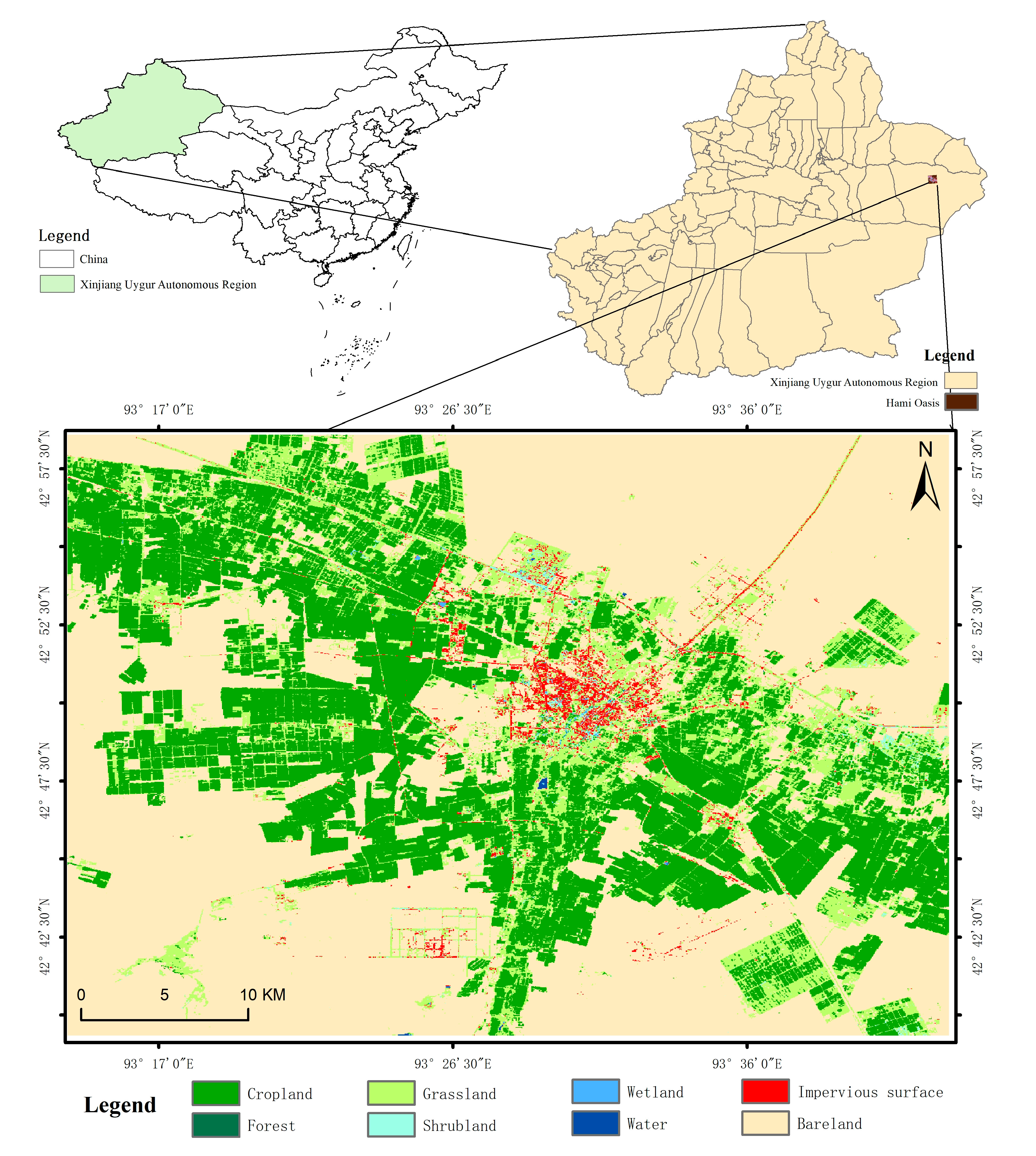
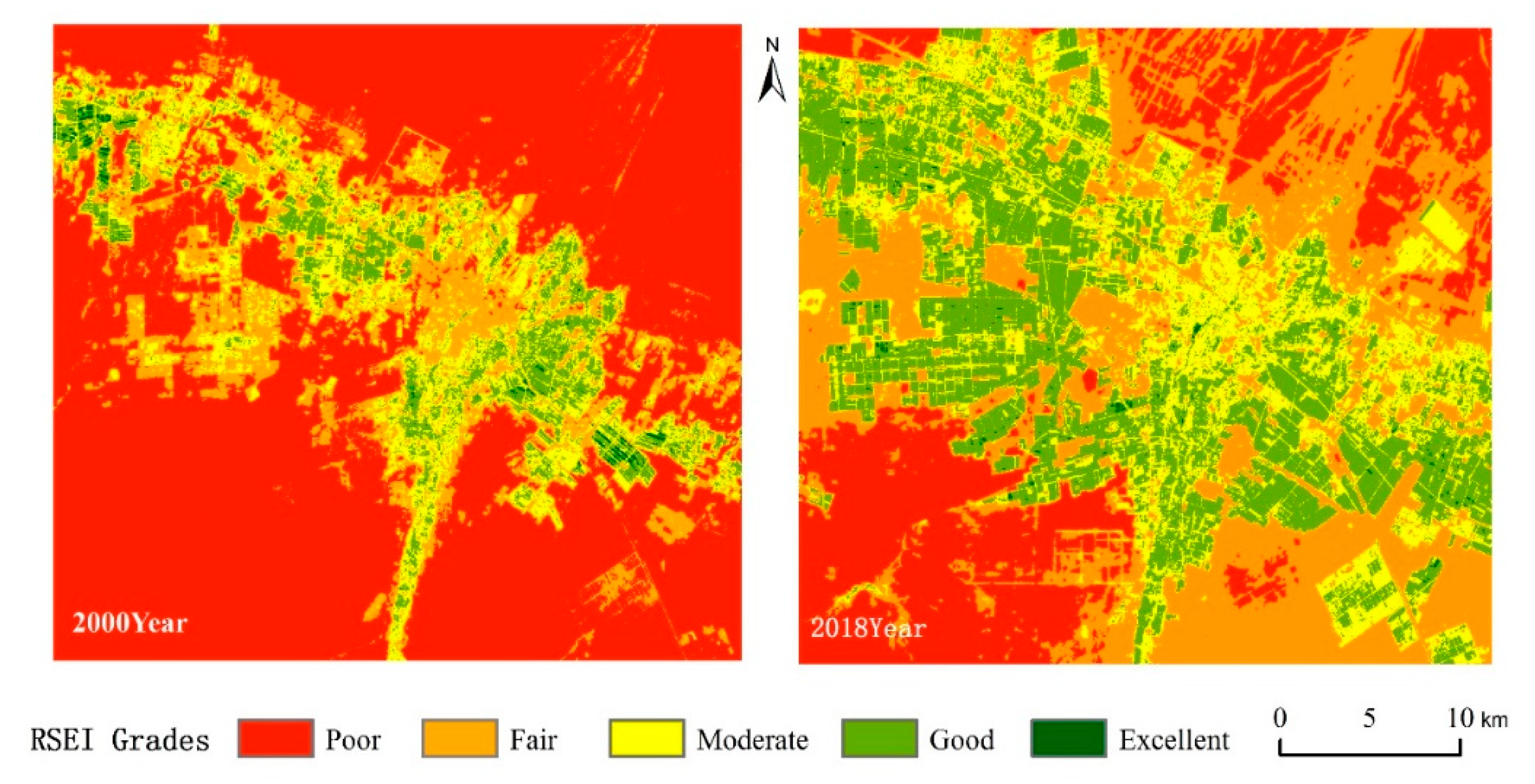
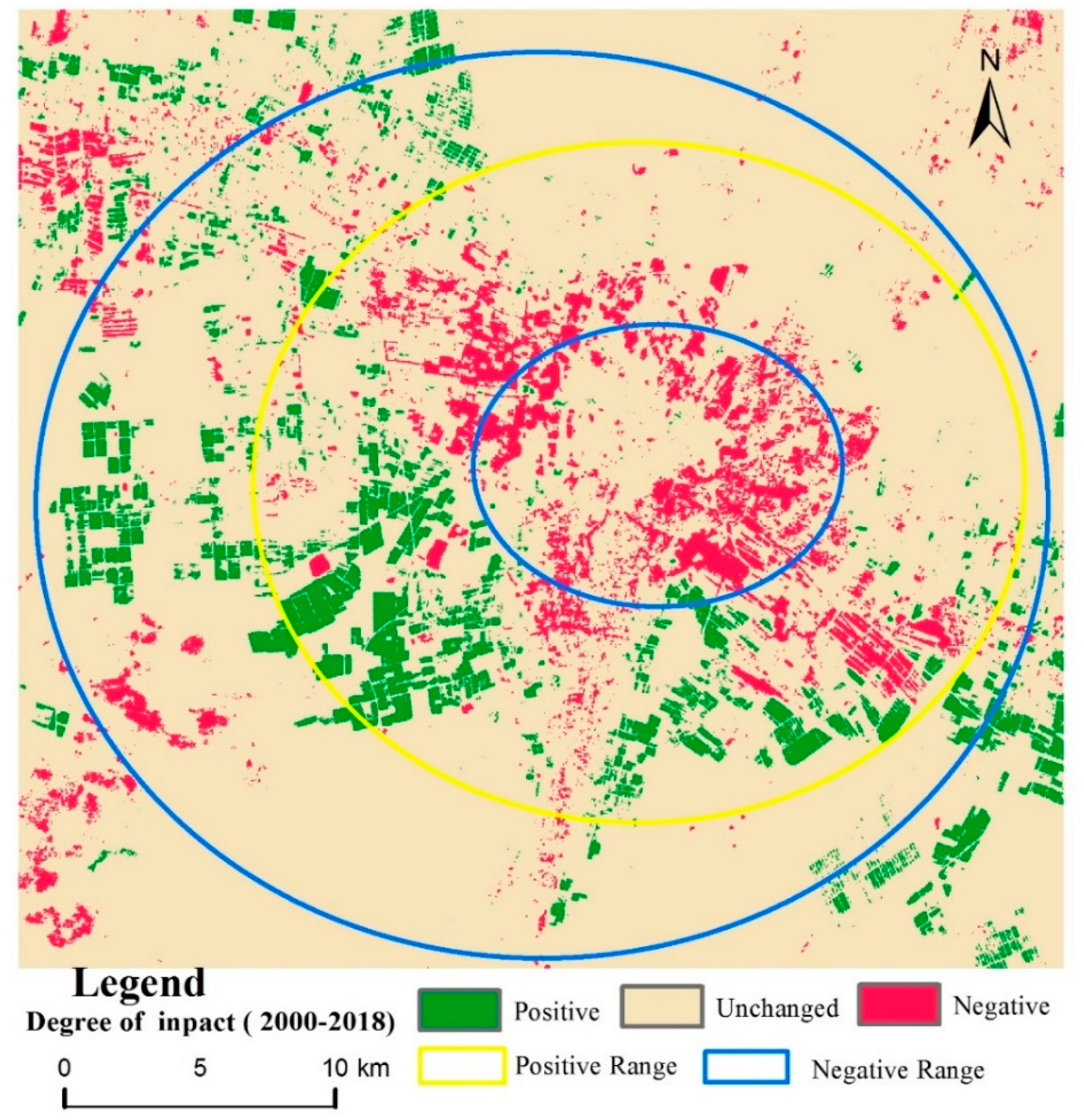
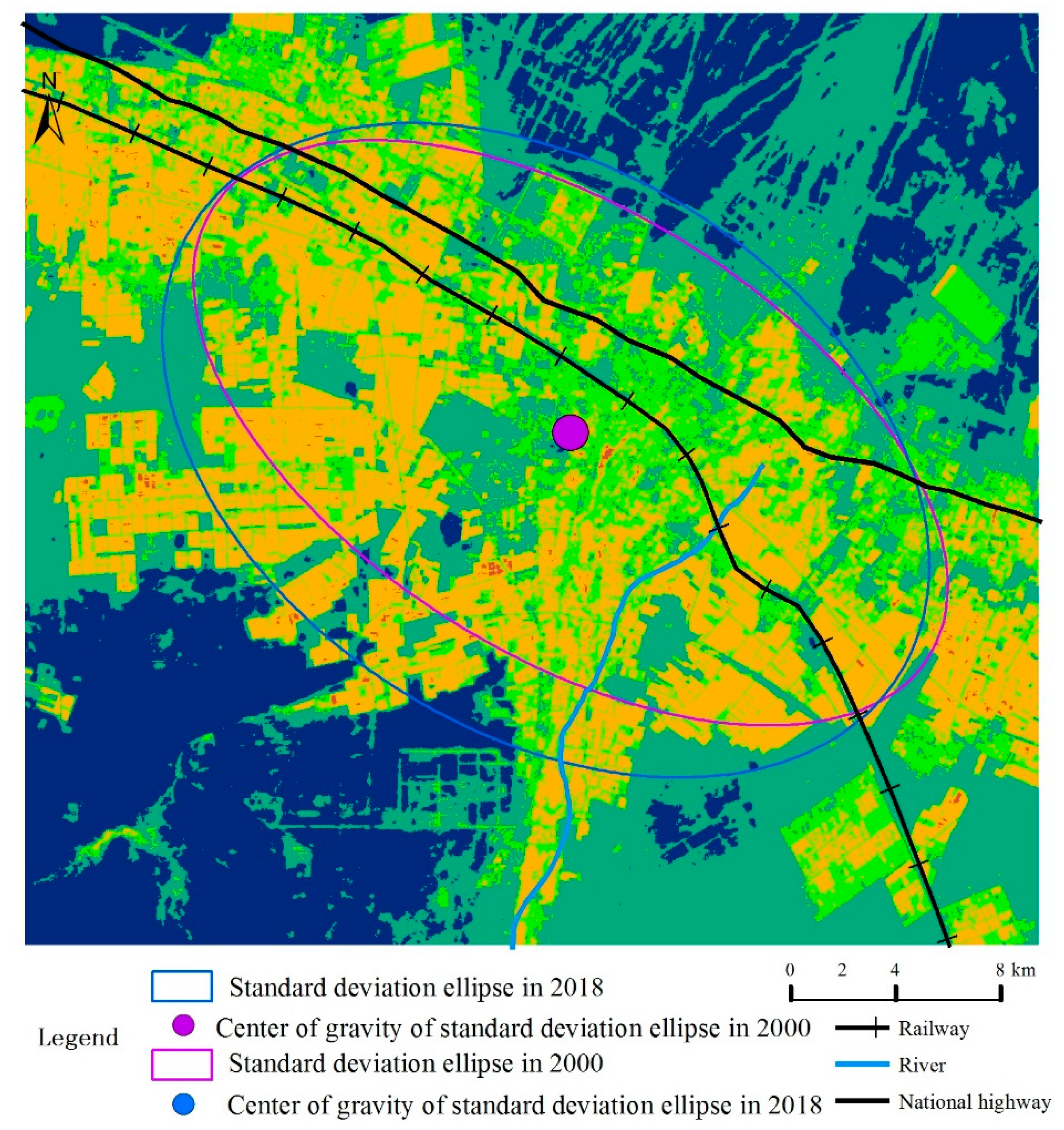
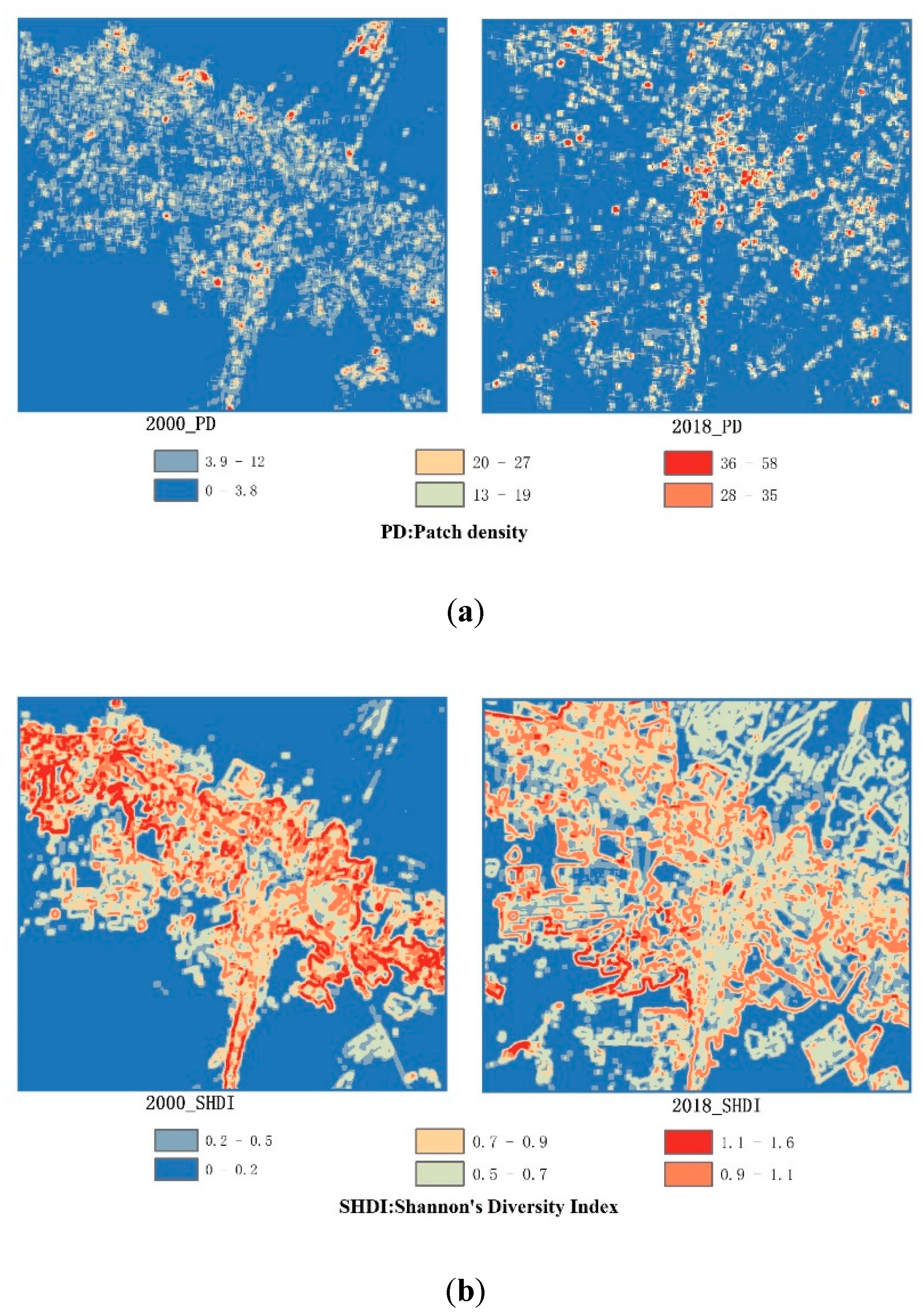


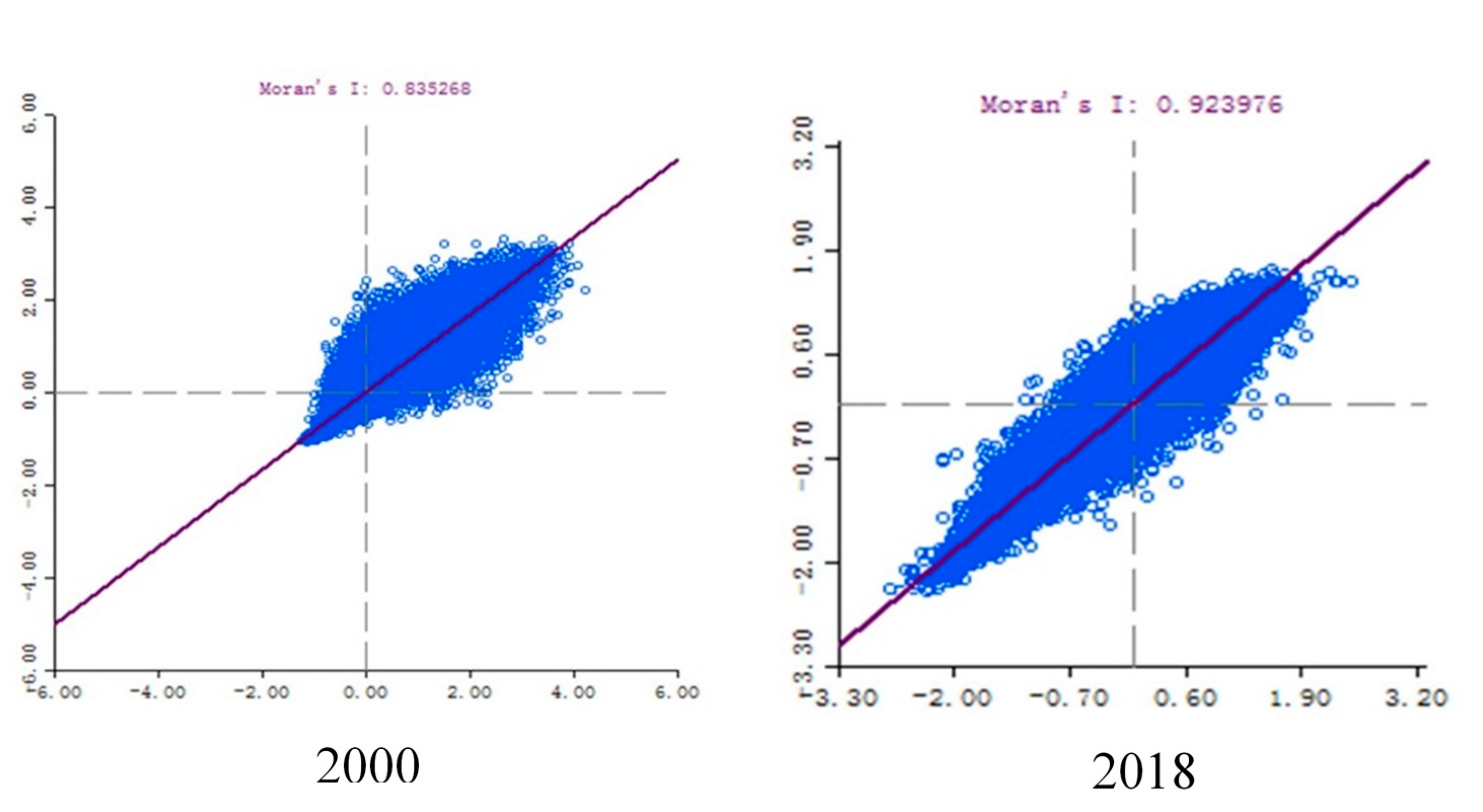

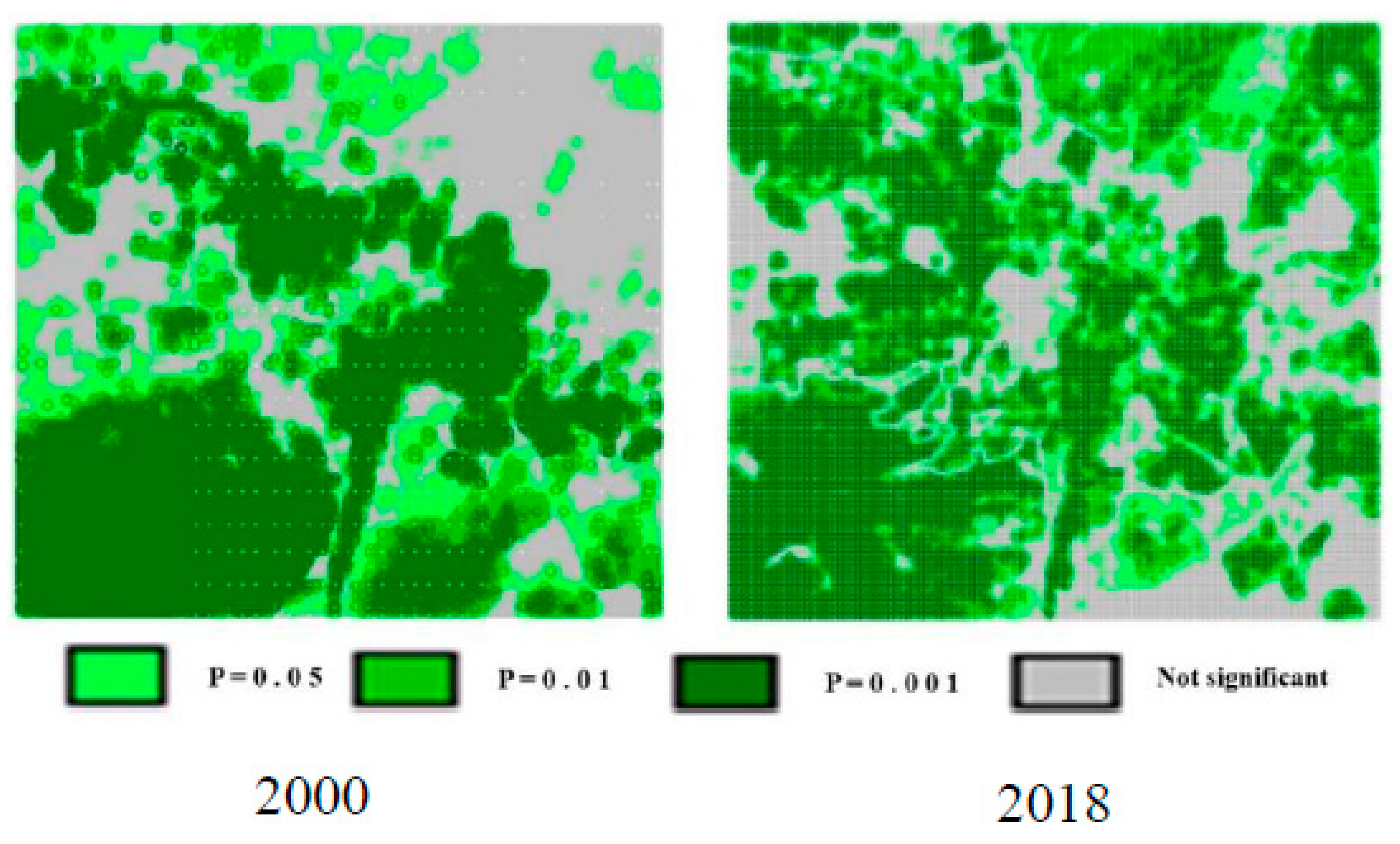
| Reference for Judging | Interaction Type |
|---|---|
| q(X1 ∩ X2) < Min(q(X1), q(X2)) | nonlinear weakening effect |
| Min(q(X1), q(X2)) < q(X1 ∩ X2) < Max(q(X1), q(X2) | single factor nonlinear weakening effect |
| q(X1 ∩ X2) > Max(q(X1), q(X2)) | mutual strengthening effect |
| q(X1 ∩ X2) = (q(X1) + q(X2)) | independence |
| q(X1 ∩ X2) > q(X1) + q(X2) | nonlinear strengthening effect |
| Variables | Standard of Classification |
|---|---|
| Slope (X1) | Extracted from DEM data and classed into five categories with natural breaks. |
| GDP (X2) | Classed into five categories with natural breaks. |
| Precipitation (X3) | Classed into five categories with natural breaks. |
| Road (X4) | Kernel density of river is created and classed into five categories with natural breaks. |
| Population density (X5) | Classed into five categories with natural breaks. |
| Temperature (X6) | Classed into five categories with natural breaks. |
| River (X7) | Kernel density of river is created and classed into five categories with natural breaks. |
| Land use (X8) | Classification of Land Use Status (GB/T21010-2017). |
| Year | Index | PC1 | PC2 | PC3 | PC4 |
|---|---|---|---|---|---|
| 2000 | NDVI | 0.615 | 0.262 | −0.334 | −0.664 |
| LSM | 0.235 | 0.638 | −0.348 | 0.645 | |
| NDBSI | 0.631 | −0.671 | −0.109 | 0.375 | |
| LST | 0.41 | 0.272 | 0.869 | 0.05 | |
| Eigenvalues | 0.047 | 0.007 | 0.003 | 0.001 | |
| Eigenvalue contribution rate (%) | 81.85 | 11.99 | 5.19 | 0.95 | |
| 2018 | NDVI | 0.678 | −0.026 | −0.141 | −0.721 |
| LSM | −0.6 | 0.462 | 0.203 | −0.621 | |
| NDBSI | 0.327 | 0.886 | −0.132 | 0.301 | |
| LST | 0.271 | 0.02 | 0.96 | 0.066 | |
| Eigenvalues | 0.062 | 0.008 | 0.003 | 0 | |
| Eigenvalue contribution rate (%) | 84.41 | 11.14 | 4.1 | 0.33 |
| Year | Item | NDVI | LSM | NBDSI | LST | RSEI |
|---|---|---|---|---|---|---|
| 2000 | Mean | 0.489 | 0.261 | 0.905 | 0.633 | 0.223 |
| Standard deviation | 0.14 | 0.087 | 0.081 | 0.156 | 0.174 | |
| Load to PC1 | 0.91 | 0.48 | −0.94 | −0.85 | ||
| 2018 | Mean | 0.505 | 0.278 | 0.942 | 0.481 | 0.396 |
| Standard deviation | 0.178 | 0.064 | 0.043 | 0.188 | 0.207 | |
| Load to PC1 | 0.94 | 0.42 | −0.86 | −0.75 |
| RSEI Grade | Year 2000 | Year 2018 | ||
|---|---|---|---|---|
| Area/km2 | Percent/% | Area/km2 | Percent/% | |
| poor (0–0.2) | 927.82 | 67.94 | 296.17 | 21.69 |
| fair (0.2–0.4) | 205.88 | 15.08 | 461.66 | 33.80 |
| medium (0.4–0.6) | 147.34 | 10.79 | 275.36 | 20.16 |
| good (0.6–0.8) | 80.94 | 5.93 | 330.17 | 24.18 |
| excellent (0.8–1) | 3.74 | 0.27 | 2.39 | 0.18 |
| Grade | 2000–2018 Year | |
|---|---|---|
| Area/km2 | Percent/% | |
| positive | 97.5 | 7.14 |
| unchanged | 1173.19 | 85.90 |
| negative | 95.03 | 6.96 |
| Slope | GDP | Precipitation | Road | Population Density | Temperature | River | Land Use | |
|---|---|---|---|---|---|---|---|---|
| q statistic | 0.056 *** | 0.545 *** | 0.489 *** | 0.122 *** | 0.51 *** | 0.325 *** | 0.114 *** | 0.647 *** |
| p value | 0.000 | 0.000 | 0.000 | 0.000 | 0.000 | 0.000 | 0.000 | 0.000 |
© 2020 by the authors. Licensee MDPI, Basel, Switzerland. This article is an open access article distributed under the terms and conditions of the Creative Commons Attribution (CC BY) license (http://creativecommons.org/licenses/by/4.0/).
Share and Cite
Gao, P.; Kasimu, A.; Zhao, Y.; Lin, B.; Chai, J.; Ruzi, T.; Zhao, H. Evaluation of the Temporal and Spatial Changes of Ecological Quality in the Hami Oasis Based on RSEI. Sustainability 2020, 12, 7716. https://doi.org/10.3390/su12187716
Gao P, Kasimu A, Zhao Y, Lin B, Chai J, Ruzi T, Zhao H. Evaluation of the Temporal and Spatial Changes of Ecological Quality in the Hami Oasis Based on RSEI. Sustainability. 2020; 12(18):7716. https://doi.org/10.3390/su12187716
Chicago/Turabian StyleGao, Pengwen, Alimujiang Kasimu, Yongyu Zhao, Bing Lin, Jinpeng Chai, Tuersunayi Ruzi, and Hemiao Zhao. 2020. "Evaluation of the Temporal and Spatial Changes of Ecological Quality in the Hami Oasis Based on RSEI" Sustainability 12, no. 18: 7716. https://doi.org/10.3390/su12187716
APA StyleGao, P., Kasimu, A., Zhao, Y., Lin, B., Chai, J., Ruzi, T., & Zhao, H. (2020). Evaluation of the Temporal and Spatial Changes of Ecological Quality in the Hami Oasis Based on RSEI. Sustainability, 12(18), 7716. https://doi.org/10.3390/su12187716







